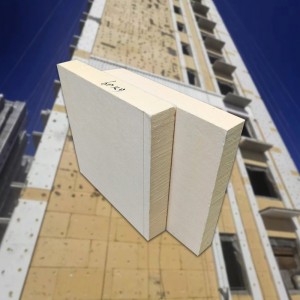 Building energy conservation is one of the focuses of natural gas conservation work, and external wall insulation has become the main product of building energy conservation. For areas where thermal insulation is the main focus in thermal design, such as severe cold areas and cold regions, external wall insulation is not only reasonable, but also applicable and has developed rapidly. For thermal design, only areas with hot summer and warm winter insulation are generally considered, or areas with hot summer and cold winter insulation as the main focus, there is room for further improvement in the external insulation of some exterior walls. Thermal insulation materials should have a low thermal conductivity, a thermal insulation effect of over 85%, and a suitable service life and price, suitable for large-scale use. Phenolic insulation foam board is a good choice for external wall insulation materials, and its excellent thermal insulation performance can greatly save energy consumption.
Building energy conservation is one of the focuses of natural gas conservation work, and external wall insulation has become the main product of building energy conservation. For areas where thermal insulation is the main focus in thermal design, such as severe cold areas and cold regions, external wall insulation is not only reasonable, but also applicable and has developed rapidly. For thermal design, only areas with hot summer and warm winter insulation are generally considered, or areas with hot summer and cold winter insulation as the main focus, there is room for further improvement in the external insulation of some exterior walls. Thermal insulation materials should have a low thermal conductivity, a thermal insulation effect of over 85%, and a suitable service life and price, suitable for large-scale use. Phenolic insulation foam board is a good choice for external wall insulation materials, and its excellent thermal insulation performance can greatly save energy consumption.
Due to the reduction of energy consumption, it can reduce the emissions of carbon dioxide and other waste, as well as the waste of non renewable resources. The main functions of external wall insulation are reflected in the following aspects:
Protecting the exterior wall surface
As the outer layer of a building, the exterior wall must withstand all external climatic influences, such as heat, cold, freezing, snow, hail, rain, and wind. Rain, temperature changes, and environmental pollution alternately and continuously act on the outer wall, causing cracks and mold to form. Buildings are damaged, residents’ bodies are affected, and heating and cooling costs have significantly increased. Compared to expensive building maintenance costs, the value of external wall insulation systems far exceeds their own costs. It wraps and protects the exterior of the building, meeting its insulation performance while greatly extending its lifespan. The external wall insulation system is the best external wall protection system for new buildings and the best maintenance system for old buildings.
Protecting the main structure and extending the lifespan of the building
Adopting an external wall insulation scheme, the insulation layer is placed on the outside of the building structure, buffering the stress caused by structural deformation due to changes in humidity, avoiding structural damage caused by rain, snow, freezing, thawing, dry and wet cycles, and reducing the erosion of harmful gases and ultraviolet rays in the air on the enclosure structure. It has been proven that as long as the selection of insulation materials for walls and roofs is appropriate and the thickness is reasonable, external insulation can effectively prevent and reduce temperature deformation of walls and roofs, and effectively eliminate common diagonal cracks or splay cracks in the top horizontal wall. Therefore, external insulation can not only reduce the humidity stress of the enclosure structure, but also protect the main structure, thereby effectively improving the durability of the main structure.
Warm in winter and cool in summer, comfortable to live in
After external insulation, due to the increase in thermal capacity of the solid walls inside the exterior walls, the indoor space can store higher heat. When the indoor air temperature is affected by unstable heat, it rises or falls, and the wall structure layer can absorb or release heat, which is conducive to maintaining stable room temperature. In summer, the external insulation layer can reduce the combined effects of solar radiation and high outdoor temperatures, resulting in a decrease in the surface temperature of the exterior wall and the temperature of the indoor air. It can be seen that external insulation of the exterior wall will make the building warm in winter and cool in summer, making living comfortable.
Post time: Sep-15-2023
